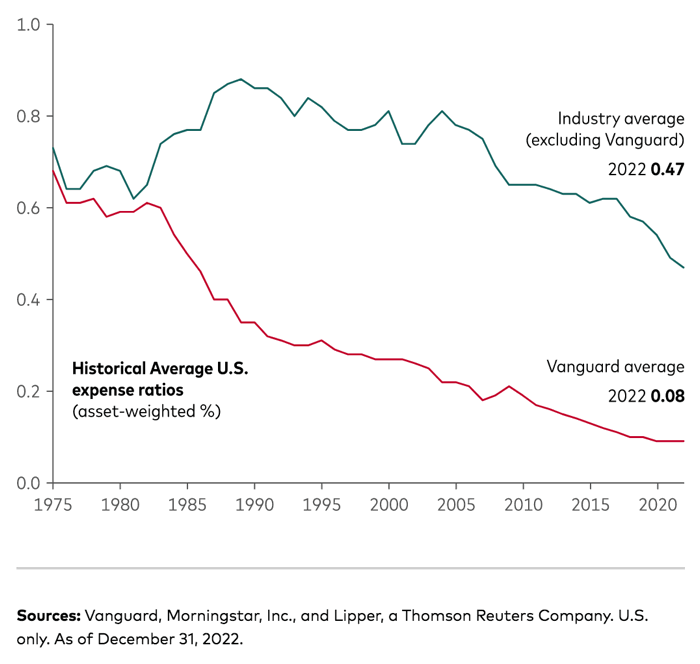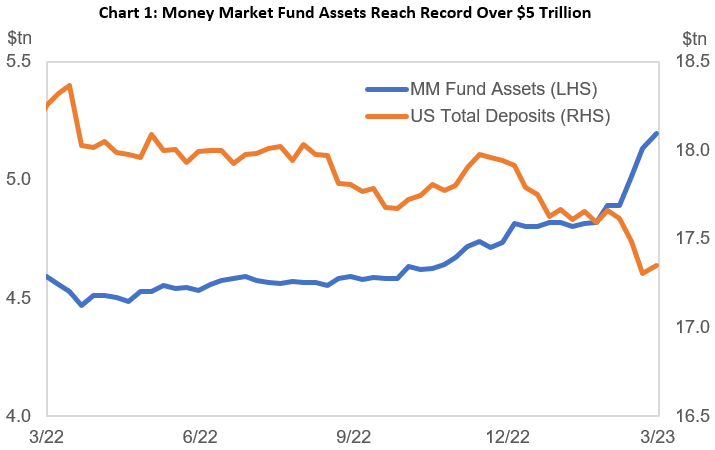 The term “Vanguard effect” was coined due to the observation that after Vanguard enters an asset class with its low expense ratios, competitors are usually forced to follow and lower their expense ratios as well. However, one area where this effect not being seen is money market funds.
The term “Vanguard effect” was coined due to the observation that after Vanguard enters an asset class with its low expense ratios, competitors are usually forced to follow and lower their expense ratios as well. However, one area where this effect not being seen is money market funds.

Part of the reason is that the megabanks are still paying basically zero, so the 4% from an average money market fund still looks great in comparison. Here’s a chart showing the nearly half-trillion dollars of bank deposits moving over to money market funds over the past year (source).

Let’s compare S&P 500 index funds. The Fidelity 500 Index Fund (FXAIX) has a tiny expense ratio of 0.015%. The Vanguard 500 Index Fund (VFIAX) has an expense ratio of 0.04%. If you assume that Vanguard is operating “at cost”, Fidelity is actually choosing to lose some money to be a little cheaper than Vanguard. If it matched Vanguard’s expense ratio, at the current size it would earn an extra $10 million. There is such a thing as “indexing skill”, but going forward you could honestly see Fidelity 500 outperforming Vanguard 500 by a slim margin.
Now let’s compare money market funds. The Fidelity Government Money Market Fund (SPAXX) has $270 billion in total assets and an expense ratio of 0.42%. This means this fund generates roughly $1+ Billion of revenue for Fidelity every year.
Meanwhile, the Vanguard Federal Money Market Fund (VMFXX) is nearly the same size at $250 billion of total assets, but only a 0.11% expense ratio. That works out to $275 million of revenue. If you assume again that Vanguard is operating “at cost”, that means Fidelity is earning an extra $800 million a year by not lowering its expense ratio to the same level.
Money market mutual funds are regulated so tightly now, especially those with “government” or “treasury” in their name, that they can pretty much only invest in the same things and thus earn the same yield. The only way that the customer earns more interest is if the mutual fund provider charges less in fees. It’s pretty much a zero-sum game.
Fidelity Government Money Market Fund (SPAXX) pays you 4.73% and pays itself 0.42%. The total yield is 5.15%.
Vanguard Federal Money Market Fund (VMFXX) pays you 5.06% and pays itself 0.11%. The total yield is 5.17%.
The pie is required to be nearly the same for both funds (same ingredients in nearly the same proportions), but with Vanguard the customer gets a much bigger slice. There is nearly zero chance that over time, Fidelity will give you a higher return on Vanguard here.
Now, there are institutional class funds with $50 million minimums that also have low expense ratios, but these are funds that Vanguard uses as their default cash sweep! I could have $100 with Vanguard and get access. The moment any capital gains, dividends, or interest payments are distributed, they are earning a competitive interest rate without any work on my part. You know what Merrill Edge pays me on my default cash sweep? 0.01%.
Vanguard published an interview with their head of taxable money market funds that covers a lot of interesting background details about money market funds: Vanguard’s Nafis Smith on the enduring advantage of low-fee money market funds. (Well, interesting to me.) Here are my highlights:
There are technically four types of money market funds (Treasury, government, municipal, and prime) and each are regulated very tightly by SEC Rule 2a-7, and even more so after the 2008 Financial Crisis.
The primary mandate of any money market fund is to seek both stability and provide current income. In a rising interest rate environment, any of these four types of money market funds—U.S. Treasury, government, municipal, and prime funds—should meet that decree. They all hold high-quality assets, are very liquid, and are subject to the same SEC regulation, Rule 2a-7, which is very prescriptive in terms of how much duration risk a fund can take on and how much liquidity must be maintained.
For example, all “government money market funds” must invest at least 99.5% of their assets in cash, U.S. Government Securities, and/or repurchase agreements that are collateralized solely by U.S, Government Securities or cash.
In terms of duration and liquidity, all taxable funds must hold at least 10% of their assets in investments that can be converted into cash within one day. At least 30% of assets must be able to be converted into cash within five business days. Finally, no more than 5% of assets can take more than a week to convert into cash.
Money market funds have only “broken the buck” (paid out less than the $1 NAV) twice, the worst case for 96 cents on the dollar.
Since their introduction in 1971, money market funds have broken the buck just two times. The first was in 1994, when a fund was liquidated at 96 cents per share because of large losses in derivatives.3 The second was during the financial crisis of 2008, because of assets held with the then recently bankrupt Lehman Brothers.4
In response to the 2008 event, the Securities and Exchange Commission amended Rule 2a-7,5 which increased the resilience of money market portfolios and made them much safer than they used to be. Since then, we’ve seen several additional rounds of reform. In short, breaking the buck was a rare event before, but since the regulations have changed, it’s even less likely to occur.
More detail on repurchase agreements and why they are more popular right now (to reduce interest rate volatility).
Fed repurchase agreements are very common in the money market space. It’s an overnight lending arrangement between us, in this instance, and the Federal Reserve, which is one of the world’s highest-quality organizations in terms of credit risk. We’re lending cash and receiving U.S. Treasuries, which are extremely high-quality securities held on the Federal Reserve’s balance sheet. The Fed buys back the U.S. Treasuries the next day at a higher price based on Fed target rates, which provides income to money markets.
In a rising interest rate environment like the one we’re experiencing, any repurchase agreements are very good at dampening market volatility because they allow us to increase stability by reducing interest rate risk. Repurchase agreements also allow us to pass along the higher interest rate to investors much more quickly.
Vanguard’s low expense ratios allows their customers to get both the highest yield AND the safest assets with a very low minimum balance requirement. This makes them the best money market funds.
Our greatest advantage is our low expense ratio, which allows us to do things differently than some of our competitors. We don’t have to take on unnecessary risk to reach for yield, and we can manage our portfolios with much shorter durations, maintain higher credit standards, and enforce stricter underwriting standards for our repurchase agreements while still offering a competitive return.
 The Best Credit Card Bonus Offers – 2025
The Best Credit Card Bonus Offers – 2025 Big List of Free Stocks from Brokerage Apps
Big List of Free Stocks from Brokerage Apps Best Interest Rates on Cash - 2025
Best Interest Rates on Cash - 2025 Free Credit Scores x 3 + Free Credit Monitoring
Free Credit Scores x 3 + Free Credit Monitoring Best No Fee 0% APR Balance Transfer Offers
Best No Fee 0% APR Balance Transfer Offers Little-Known Cellular Data Plans That Can Save Big Money
Little-Known Cellular Data Plans That Can Save Big Money How To Haggle Your Cable or Direct TV Bill
How To Haggle Your Cable or Direct TV Bill Big List of Free Consumer Data Reports (Credit, Rent, Work)
Big List of Free Consumer Data Reports (Credit, Rent, Work)
Merrill Edge and TDAmeritrade belong in the hall of shame for having default sweeps that pay you next to nothing.
Haha, true. They should feel more pressure as interest rates stay high. I have dividend alerts at Merrill Edge four times a year (limited holdings used for Preferred Rewards) and then instantly sweep to BofA checking, which is then swept out into higher interest stuff.
It’s not a sweep, but TTTXX is available at Merrill Edge with a $1000 minimum.
Yup, there are definitely options out there for each brokerage, if you put in the effort to look and make some trades (and wait for settlement in some cases). I’ve tried to list them here for Merrill Edge:
Merrill Edge Brokerage: Best High Interest Rate Options on Cash
Yeah Merrill lost my 7 figure account today due to this and there bureaucratic business practices.
One difference between Vanguard and Fidelity’s money market funds, that might justify the higher ER for some people, is that you can write a check, do an ATM withdrawal, or pay a bill directly out of a Fidelity MM fund. No selling first necessary, no minimum amount, etc. Essentially a checking account paying almost 5% yield.
You can establish checkwriting for the Vanguard brokerage account settlement fund (VMFXX). ATM withdrawal and bill pay, no.
That’s a good point. Vanguard apparently decided they couldn’t handle that level of customer service required. Although I still wouldn’t keep a large balance in my Fidelity CMA.
Why wouldnt’ you keep a large balance in your Fidelity CMA?
Fzfxx is our go-to fund. All bills are easily paid with this money market fund. We are constantly earning above avg returns daily without having to move money around to pay from a checking account. The fee charged is reasonable for the convenience factor to us.
We keep our spare cash for emergency fund in SPRXX, which has a slightly higher yield than FZFXX lately. I am not sure how the risks differ for each core Money Market fund.
Maybe it’s due to being on the younger end but I’ve never seen Merrill as anything other that something to be avoided. When it was purchased by BofA it made it only more compelling to stay away.
One question on VMFXX. It says it’s SEC yield is 5.06% but I thought the yield of a fund was before expense ratios so wouldn’t that make your slice of the pie 4.95% and Vanguard’s 0.11% w/ the same adjustments to Fidelity?
When you see SEC yield, that number is after expenses are taken out (net of expenses). Same for bond funds and ETFs and such.
so we do get 5.06%, not 4.95%? the 5.06% is comparable with bank APY?
You get the 5.06% in this case. Bank APY is after compounding, to compare directly you would want the “compound yield”, in this case 5.18%. You can find it here:
https://investor.vanguard.com/investment-products/mutual-funds/profile/vmfxx
But note that the interest rate on a money market fund changes daily.
Jonathan is talking about the middle one, it looks the first 5.08% is the bests since they all had “Federal” word, equally safe, not sure if I am correct.
VMRXX
Vanguard Cash Reserves Federal Money Market Fund Admiral Shares Short-term U.S. government securities $3,000 5.08% 0.10%
VMFXX
Vanguard Federal Money Market Fund Short-term U.S. government securities $3,000 5.06% 0.11%
VUSXX
Vanguard Treasury Money Market Fund Short-term U.S. Treasuries $3,000 5.07% 0.09%
The dollar amount of interest is so low that these rate differences would be trivial, assuming you only have enough in your MM account for liquidity, emergencies, etc. But for any meaningful amount of savings, a better interest rate can be earned from Treasury bills. Fidelity’s MM rates are slightly lower than Vanguard’s, but Fidelity has features equivalent to a checking account (ACH debiting, ATM, checkwriting with no minimum amount, etc.) as well as auto-roll for T-Bills.
My TDAmeritrade just moved over to Schwab and they (Schwab Advantage SWVXX) come in closer to Vanguard than Fidelity. They have tended to be .1% behind Vanguard over the last few weeks (though lagging .2% now after rate change). It still pays to buy Tbills directly if you dont need the funds too fluid. Four week and 8 week Tbills are .2-.25% ahead of Vanguard (as of 7/27 auction). It’s quite a relief to finally be back over 5% on funds like this…..
The only annoying thing about Vanguard is that you cant seem to transfer bank money directly to some money market funds; you have to go through your settlement account (2 step process). Not sure if I have something set up wrong. I use different versions of the money market funds as sub accounts for bucket uses.
Hey Jonathan, I have been reading and learning from this blog since 2006! Question: would you personally invest funds that you need to have liquid access to in a money market fund rather than a high-yield savings account? It appears that although money market funds can technically lose money, they very, very rarely do, and although they are not FDIC insured, the risk is pretty much nil. So at this point, I can see little reason not to move my funds into VMFXX, which has a better yield than almost any account out there. Thoughts?
Yes, I would invest in a government/federal money market fund that is run by a reputable firm like Vanguard, Fidelity, Schwab, Blackrock, etc.
Thanks for being a longtime reader!